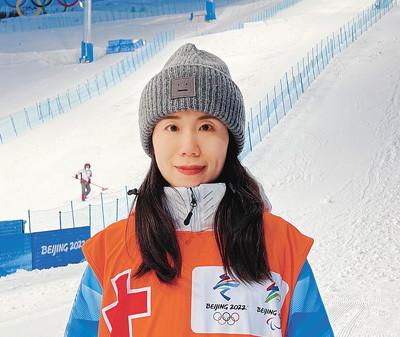
I work in the Department of Anesthesiology at Peking University Third Hospital and have always loved skiing. In 2017, some ski-loving employees of the Third Hospital of Beijing Medical College established a ski association, and I became one of them. In 2018, I saw the news that the Beijing Winter Olympic Organizing Committee selected ski doctors, and I did not hesitate to sign up. After registration, I first took the basic skiing skills test organized by the Beijing Winter Olympics Organizing Committee, and after successfully passing, after more than 3 years of training, I finally became a glorious ski doctor.
Snow sports at the Winter Olympics, such as alpine skiing and freestyle skiing, are fast and skillful. If an athlete is injured, a ski doctor needs to quickly slide from the pistes to the injured person, check the injury, do first aid and complete the transfer – that's my job. During the rescue, I not only had to step on my skis, but I also had to carry a first-aid backpack weighing 15 kilograms. Therefore, ski doctors must have relatively skilled skiing skills, but also have excellent first aid knowledge and skills.
Ski skills training on the slopes is very important, it includes training on different steepnesses, slopes, terrain, and some auxiliary training; in terms of first aid training, it is necessary to master CPR and common head trauma and spinal injury first aid skills, which I have rarely been exposed to in my past work. In addition, I have to face athletes from different countries and regions at the Winter Olympics, and in order to communicate with them smoothly, I need to learn English terminology related to skiing. Due to the needs of epidemic prevention and control, epidemic prevention is also one of our training priorities.
Pistes training is hard. In the middle of winter, the temperature at the training ground is very low. When I first started training, it was common to fall and get injured. However, when the task is really out, the situation is still relatively urgent. During the race, at intervals on the track, there will be a ski doctor station, each station is equipped with two ski doctors and two patrols.
During the Beijing Winter Olympics, I was assigned to the Genting Ski Park in Zhangjiakou. There are many snow skills in this field, such as freestyle skiing aerial skills, slope obstacle course skills, U-shaped track skills and so on. These events are fast and difficult, and the relatively high probability of injury of athletes puts higher demands on us. The Organizing Committee of the Winter Olympics requires us to rush to the injured athletes within 4 minutes, but in fact, when we actually compete, we may only have one or two minutes of treatment time. Because we have to transport injured athletes quickly, it does not affect other athletes to compete. Therefore, only after a long period of training and practice can athletes be treated in time without affecting the competition.
I am fortunate and proud to be a ski doctor and serve the Winter Olympics. During the Beijing Winter Olympics, I hope that I can successfully play the skills I have learned in the past few years when needed, but I hope that the athletes will be safe and secure, play wonderfully, and achieve good results!
(The author is the attending physician of the Department of Anesthesiology of the Third Hospital of Peking University, the ski doctor of the Beijing Winter Olympics, and the reporters of this newspaper, Shen Shaotie and Yang Yanfan, interviewed and sorted out)
People's Daily ( 2022-02-09 13th edition)